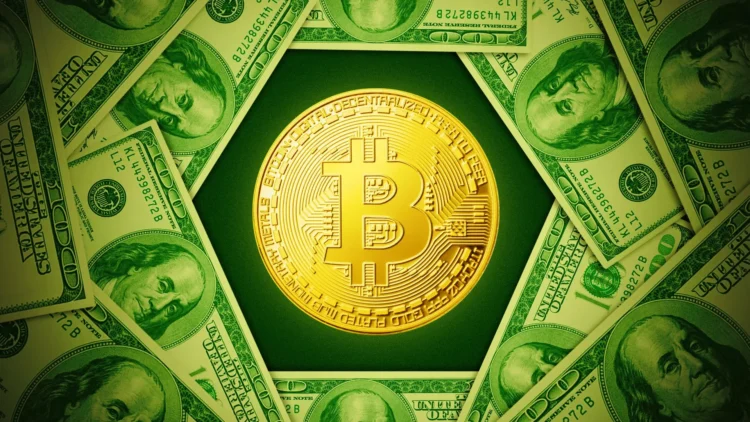In a recent interview with Bloomberg, former IMF Chief Economist and Harvard professor Ken Rogoff reignited debate by suggesting that cryptocurrencies could pose a long-term challenge to the U.S. dollar’s dominance as the global reserve currency. His comments reflect growing concern among economists and policymakers about the disruptive potential of digital assets in reshaping the global financial system.
This matters because the U.S. dollar currently underpins international trade, global finance, and central bank reserves, giving the United States enormous economic influence. Any threat to this U.S. dollar’s dominance could significantly alter global monetary dynamics, geopolitical relationships, and financial stability.
The key question now is whether crypto assets, especially decentralized ones like Bitcoin or government-backed CBDCs, represent a legitimate challenge to the dollar’s supremacy, or if these warnings remain largely speculative given crypto’s current limitations.
The Core of Rogoff’s Argument
Ken Rogoff’s core concern is that cryptocurrencies, particularly Bitcoin, stablecoins, and DeFi, have the potential to bypass traditional financial intermediaries, thereby undermining the U.S. government’s ability to exert control over global financial flows. He warns that if crypto adoption continues to grow, it could erode the influence of institutions like the Federal Reserve and reduce the effectiveness of sanctions, monetary policy, and capital controls.
Rogoff points to Bitcoin’s borderless and decentralized nature as a threat to centralized monetary authority. However, he also emphasizes the growing use of stablecoins, which are pegged to fiat currencies like the U.S. dollar but operate outside the direct oversight of central banks. These stablecoins, especially when integrated with DeFi platforms, could enable international transactions without touching the traditional banking system.
This concern is grounded in the historical context of the U.S. dollar’s dominance. Since World War II, the dollar has been the cornerstone of international trade and the preferred reserve currency for central banks. This position gives the U.S. strategic economic power, which could be gradually diluted if crypto enables parallel financial ecosystems to flourish beyond regulatory reach.
How Crypto Challenges Dollar Hegemony
As global crypto adoption accelerates, digital assets are increasingly seen as tools that can reduce dependence on the U.S. dollar in international finance.

Cross-border payments are becoming decentralized and dollar-independent
Cryptocurrencies like Bitcoin and Ethereum are enabling faster, cheaper cross-border transactions without the need for U.S. dollar intermediaries or SWIFT-based systems. This decentralized payment infrastructure reduces reliance on the dollar and traditional financial institutions, particularly in regions with capital controls or weak banking systems.
Stablecoins like USDT and USDC are operating outside traditional banking
Stablecoins pegged to fiat currencies, especially USDT (Tether) and USDC (USD Coin), are widely used in crypto trading and cross-border remittances. Though dollar-denominated, they function independently of the U.S. banking system, allowing users to store and transfer digital dollars without being subject to standard U.S. regulations.
Emerging economies turning to crypto as a hedge against USD volatility
In countries facing inflation, currency devaluation, or sanctions, both individuals and institutions are increasingly turning to crypto assets to preserve value and conduct trade. This bypasses reliance on the dollar as a reserve asset and payment medium, particularly in places like Argentina, Nigeria, and Turkey.
The rise of Central Bank Digital Currencies (CBDCs) is challenging the USD’s role in trade
Nations such as China are developing and piloting CBDCs like the digital yuan, which are designed to facilitate international trade and settlement without involving the U.S. dollar. CBDCs could offer state-backed alternatives to dollar-based transactions, potentially shifting the geopolitical balance of economic power.
RELATED: Is China’s Yuan Stablecoin a Power Move or Innovation
Counterarguments: Why the Dollar Isn’t Dead Yet
While crypto technologies are advancing rapidly, several fundamental strengths continue to secure the U.S. dollar’s dominance in global finance.
Why the Dollar Isn’t Dead Yet
- The dollar’s deep entrenchment in global reserves, trade, and oil markets
- Crypto’s volatility and lack of universal trust
- Regulatory headwinds for crypto globally
- U.S. institutions’ adaptability
The dollar’s deep entrenchment in global reserves, trade, and oil markets
Roughly 60% of global foreign exchange reserves are still held in U.S. dollars, and the majority of global trade, especially in oil and commodities, is priced in USD.
This dominant role creates a reinforcing cycle: countries and corporations continue to rely on the dollar due to its liquidity, stability, and universal acceptance. Shifting away from this entrenched system would require not only technological change but massive political and economic coordination.
Crypto’s volatility and lack of universal trust
Despite their potential, cryptocurrencies still suffer from price swings that can destabilize portfolios and payment systems. For example, Bitcoin’s value can fluctuate by thousands of dollars in a single day. This unpredictability makes crypto impractical for long-term contracts or international settlements.
Furthermore, trust issues persist due to frequent scams, security breaches, and the lack of a centralized authority to provide legal or consumer protections, all of which undermine its appeal as a reserve currency.
Regulatory headwinds for crypto globally
Governments around the world are increasingly tightening the reins on crypto. The U.S. SEC, for example, has taken enforcement actions against major exchanges and tokens, while other countries like China have outright banned crypto trading and mining.
These unpredictable and sometimes harsh regulations make it difficult for crypto to achieve the level of legal and financial recognition necessary to compete with fiat currencies in a meaningful way.
U.S. institutions’ adaptability
Instead of being displaced, U.S. financial institutions are evolving alongside crypto by supporting regulated dollar-pegged stablecoins like USDC. These digital assets combine the speed and efficiency of blockchain with the stability of the U.S. dollar.
Moreover, the potential development of a U.S. central bank digital currency (CBDC) further demonstrates America’s ability to innovate within the system, reinforcing the dollar’s position rather than surrendering it to decentralized alternatives.
Global Reactions and Shifting Dynamics
As crypto’s global footprint expands, countries and regions are reassessing their dependence on the U.S. dollar, potentially reshaping the international financial order.
Countries actively reducing dollar reliance (e.g., BRICS, China, Russia)
Nations like China and Russia, along with the BRICS bloc (Brazil, Russia, India, China, South Africa), are actively working to reduce their reliance on the U.S. dollar in trade and financial reserves.
Initiatives like settling oil trades in yuan or rubles, and the exploration of a BRICS digital currency, reflect a broader de-dollarization movement. These efforts are partly driven by geopolitical tensions, sanctions, and a desire to regain monetary sovereignty.
Crypto adoption trends in the Global South
Many countries in the Global South, such as Nigeria, Argentina, and Venezuela, are seeing rapid grassroots crypto adoption. This trend is fueled by inflation, currency instability, limited access to banking services, and high remittance fees.
Cryptocurrencies and stablecoins offer a more accessible and efficient alternative to local currencies and dollar-based systems, giving individuals greater control over their financial lives.
How international finance could bifurcate between traditional and decentralized systems
We may be witnessing the early stages of a bifurcated financial system: one rooted in traditional institutions (central banks, fiat currencies, SWIFT), and another operating through decentralized networks using crypto, stablecoins, and blockchain-based platforms.
This dual-track evolution could lead to new alliances, competition over settlement systems, and parallel economies where crypto-native finance thrives outside the influence of dollar-dominated structures.
The Future of Currency Power
As digital assets rise and geopolitical shifts intensify, the traditional U.S. dollar’s dominance faces new questions: will it adapt, share space, or lose its edge in a rapidly changing financial space?
Will crypto serve as a supplement, not a replacement, to fiat currencies?
Most experts believe cryptocurrencies are more likely to complement, rather than replace, fiat currencies. Bitcoin and stablecoins, for instance, serve as alternative stores of value and efficient tools for cross-border payments. Still, they lack the full legal, monetary, and fiscal backing that fiat currencies offer. In this scenario, crypto acts as a parallel system that supports niche use cases while fiat retains its role in national economies.
Potential for a multipolar financial world: USD, digital yuan, euro, crypto
The future may see a multipolar currency landscape where several financial systems co-exist: the U.S. dollar maintains its foundational role, the digital yuan and euro gain regional influence, and crypto assets function across borders. This shift could reduce the overdependence on any one currency and diversify global trade and finance options, especially as countries pursue strategic monetary independence.
How U.S. crypto regulation may either reinforce or weaken dollar strength
U.S. regulatory policy toward crypto will significantly shape the dollar’s future role. Supportive, innovation-friendly regulation could help U.S.-based stablecoins and blockchain infrastructure extend the dollar’s global utility. In contrast, overly restrictive policies may push innovation offshore, giving rival systems, like the digital yuan or decentralized platforms, a competitive edge in the emerging digital economy.
Final Thoughts
Despite its volatility, crypto is altering how value moves across borders and how people think about financial sovereignty. Rather than overthrowing fiat currencies, it’s forcing legacy systems to adapt, modernize, and integrate elements of decentralization. This reshaping could lead to a more dynamic and competitive global monetary system.
Rogoff’s cautionary note is particularly relevant for countries facing inflation, weak banking infrastructure, or capital controls. In these settings, crypto often acts as a functional alternative, making his warning more than just academic. It reflects real-world shifts where populations are already turning to digital assets for stability and access.
The U.S. dollar isn’t disappearing anytime soon, but its unchallenged dominance is being tested. As crypto infrastructure grows and regulatory clarity improves globally, we may witness a slow redistribution of financial influence. The key challenge for the U.S. will be to regulate wisely, balancing innovation with control, to retain its monetary leadership in a digital age.
Disclaimer: This article is intended solely for informational purposes and should not be considered trading or investment advice. Nothing herein should be construed as financial, legal, or tax advice. Trading or investing in cryptocurrencies carries a considerable risk of financial loss. Always conduct due diligence.
If you would like to read more articles like this, visit DeFi Planet and follow us on Twitter, LinkedIn, Facebook, Instagram, and CoinMarketCap Community.
Take control of your crypto portfolio with MARKETS PRO, DeFi Planet’s suite of analytics tools.”





















